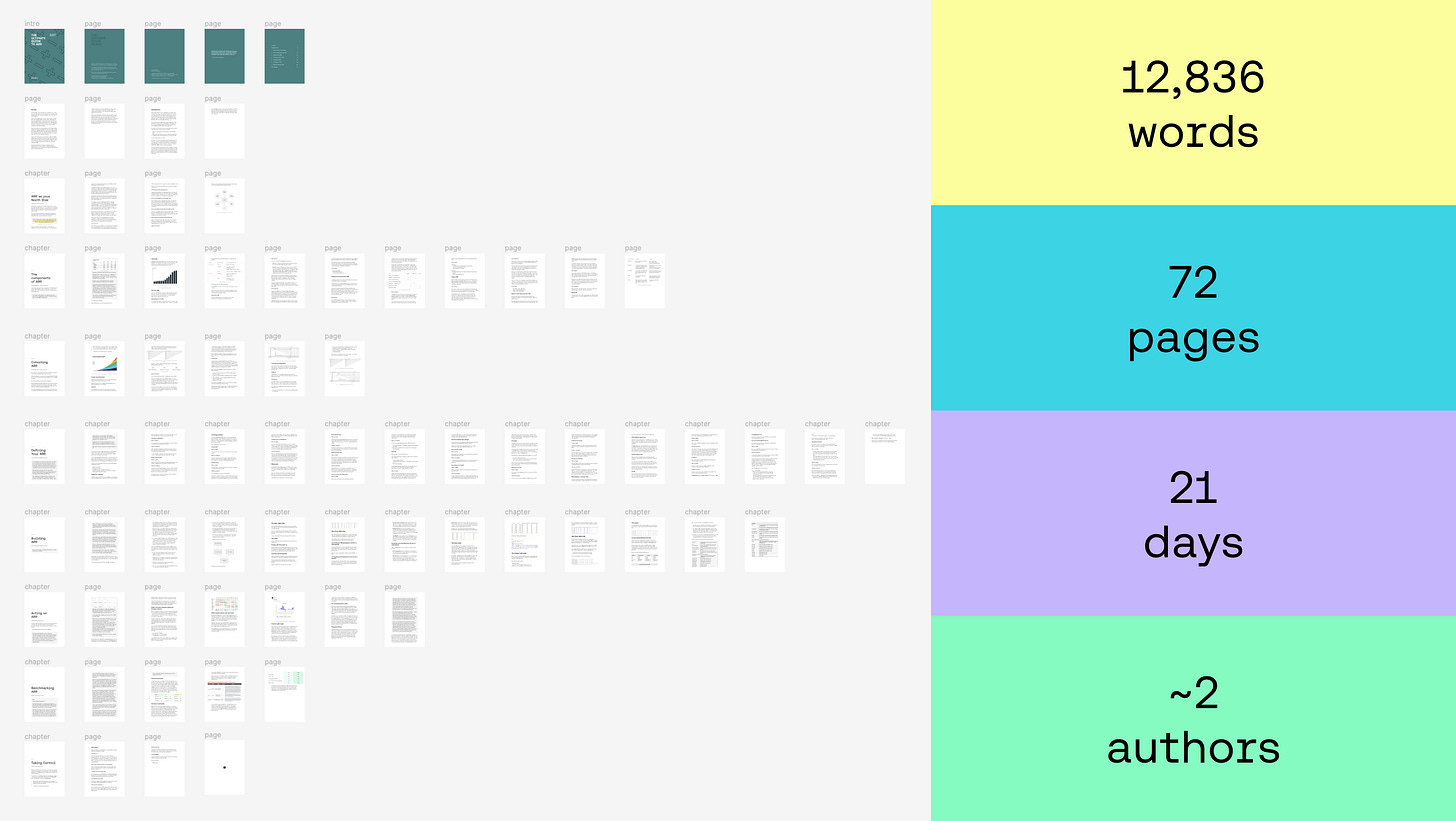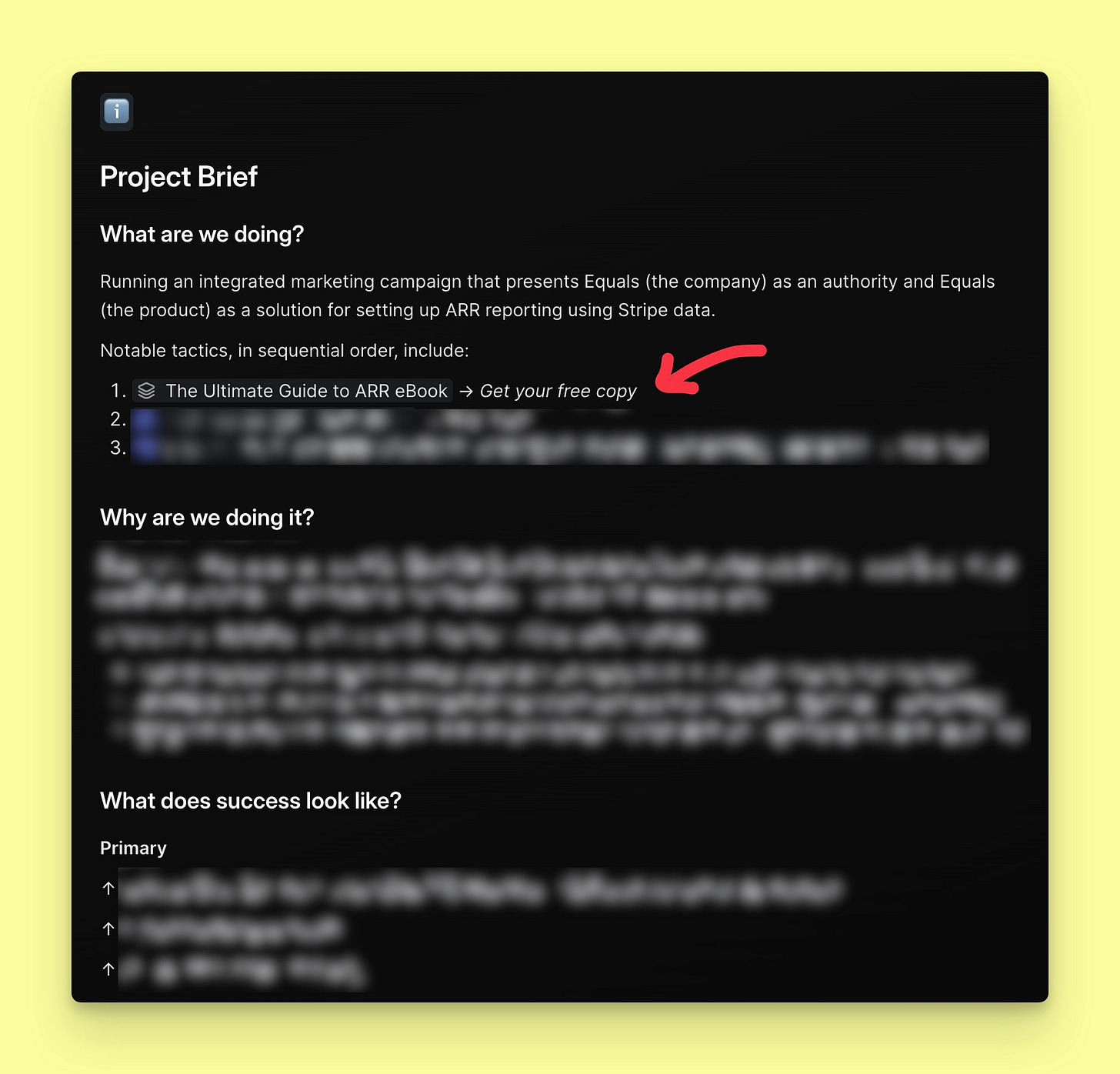On publishing our first book
Writing a book sounds daunting. Because it is. This is the story of how we published The Ultimate Guide to ARR–all 72 pages of it. In three weeks.
“Be an authority on and destination for topics target audiences care about.”
This was one part of the three-part go-to-market strategy we penned towards the end of 2023. The “reboot” of Wrap Text was our first big initiative. Publishing The Ultimate Guide to ARR was our next.
The strategy
It all started back in early March. We were in the thick of exploring Sales Only Land, learning first-hand from leads the problems they were hoping to solve with Equals. One stood out—one that we knew we could solve really well—ARR reporting with Stripe data.
Knowing what we wanted to sell, we devised a plan to drive awareness of Equals amongst target customers. The book was just one of a few tactics we would tackle as part of a broader campaign.
On March 7th, I wrote a brief for what would become an actual book–ISBN and all.
Three weeks later, it was published.
The production
21. That’s the number of days that passed between Bobby Pinero and Chris Burgner writing the first words in a Google Doc and Martin Rariga hitting export on the designed book in Figma.
We were fortunate that both Bobby and Chris were experts on the topic. We also had multiple pieces of content produced in the past that we could pull from, like Bobby’s piece, Revenue is the best north star metric, and Chris’s post, How to build a single source of truth for ARR.
We had a head start. Bringing on old friend and content expert John Collins to help gave us an even bigger leg up. And locking Bobby and Chris in a room together for a full week to focus 100% on writing helped, too.
The distribution
We are no strangers to ebooks thanks to our time at Intercom, where we helped co-author and distribute a few, including Intercom on Starting Up and Intercom on Marketing. Our past experience meant we had more than a handful of ideas about how to actually distribute the book. We opted for simplicity.
Once we had confidence in a publishing window – a week – for the finished book, we began building hype ahead of its launch. We started by publishing the Genesis and Introduction sections of the book on Wrap Text.
It (and amplification posts on social) linked to a landing page where we captured the email addresses of the 261 people who “reserved” their free copy ahead of launch.
A week later, we made the book available to everyone. There were no lengthy forms to fill out. All we asked for was an email address to send a download link to. That’s it.
We sent an email to everyone who had reserved a copy, as well as all our existing customers, with a link to download the book in PDF format. And we set up an automated email that would be sent to anyone who requested a copy in the future.
We timed the book's launch to coincide with our promotion of a new offering, ARR Reporting with Stripe, which Bobby covered in his piece; ARR reporting is never one-size-fits-all. As expected, we saw an initial pop of new requests for the book, which have since slowed. Yet, it’s encouraging to see continued organic growth in requests with little to no additional (and zero paid) promotion.
The second (much smaller) spike annotated in the chart above is an example of the power of publishing content on a regular cadence. The spike coincided with Ben’s most recent post, Navigating your idea map, which brought fresh eyes to Wrap Text and, subsequently, new requests for the book as it’s featured on the homepage.
The reception
We debated whether to share this, since we had no obvious benchmark to compare performance against. Given the niche nature of the topic, with 1,000+ (known) downloads and counting, we’re chalking this one up as a success.
We’re more confident about this when we look at some of the feedback we’ve received and the calibre of people requesting the book—finance leaders and operators at amazing companies like Amazon, Perplexity, Vanta, Ramp, Snowflake, Plaid, Incident, Intercom, Webflow, and more.
We suspect the actual number of downloads and views of the book is much higher due to the ease of sharing the link to download the book and the PDF file itself. We knew this going in, and as mentioned, we opted for simplicity and speed to market.
The end
Do we have another book in us? Heck yeah. When will it drop? This year. So, make sure you keep a spot on your digital bookshelf for our second book. For now, I’ll leave you with some lessons learned from publishing our first.
Thanks for reading.
On editing
While Google Docs is a great tool for writing, it’s particularly messy when you have more than one editor. We effectively had four—Bobby and Chris were the actual authors, while John and I tag-teamed on the editing. Keep track of what had already been “edited” and what still needed “editing” was a bit of a black box. It didn’t help that we were working across the US, Ireland, and Australia. But hey, we got it done. And with only a single (known) typo.
If we were to do it all over again, we’d probably either look for a tool more fit for purpose or be more disciplined about using Google’s Suggested edit mode and nominating a single “approver”.
On ISBN’s
This is a legit site for purchasing an ISBN, which you can buy in packs. We bought 10 since you need one for every format you produce your book in.
Did I say we had plans for a limited edition hard copy? You didn’t hear it from me.🤫
On distribution
We didn’t know there would be a lengthy delay between someone submitting their email address and receiving the automated email with a link to download the book. Due to a limitation with our current setup, people could be waiting for up to an hour to receive the email with the download link, which we felt was unacceptable. Instead of implementing a new solution, we simply opted to display a download link on the landing page immediately after email submission. We still send the email for safekeeping.












